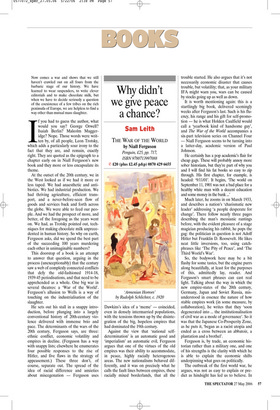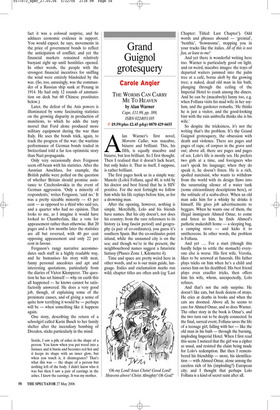Why didn’t we give peace a chance?
Sam Leith
THE WAR OF THE WORLD by Niall Ferguson Penguin, £25, pp. 717, ISBN 9780713997088 ✆ £20 (plus £2.45 p&p) 0870 429 6655
Now comes a war and shows that we still haven’t crawled out on all fours from the barbaric stage of our history. We have learned to wear suspenders, to write clever editorials and to make chocolate milk, but when we have to decide seriously a question of the coexistence of a few tribes on the rich peninsula of Europe, we are helpless to find a way other than mutual mass slaughter.
If you had to guess the author, what would you say? George Orwell? Isaiah Berlin? Malcolm Muggeridge? Nope. Those words were written by, of all people, Leon Trotsky, which adds a particularly sour irony to the fact that they are, and remain, exactly right. They are quoted as the epigraph to a chapter early on in Niall Ferguson’s new book and they more or less encapsulate its theme.
At the outset of the 20th century, we in the West looked as if we had it more or less taped. We had anaesthetic and antibiotics. We had industrial production. We had thriving agriculture, efficient transport, and a never-before-seen flow of goods and services back and forth across the globe. We were able to feed our people. And we had the prospect of more, and better, of the foregoing as the years went on. We had, as Trotsky pointed out, techniques for making chocolate milk unprecedented in human history. So why on earth, Ferguson asks, did we spend the best part of the succeeding 100 years murdering each other in unimaginable numbers?
This doorstop of a book is an attempt to answer that question, arguing in the process (unexceptionably) that the century saw a web of complexly connected conflicts that defy the old-fashioned 1914-18, 1939-45 periodisations, and that need to be apprehended as a whole. One big war in several theatres: a ‘War of the World’. Ferguson’s allusion to Wells is a way of touching on the industrialisation of the slaughter.
He sets out his stall in a snappy introduction, before plunging into a largely conventional history of 20th-century violence delivered with immense brio and pace. The determinants of the wars of the 20th century, Ferguson says, are three: ethnic conflict, economic volatility and empires in decline. (Ferguson has a way with snappy lists; elsewhere he enumerates four possible responses to the rise of Hitler, and five flaws in the strategy of appeasement.) These three don’t, of course, separate out. The spread of the idea of racial difference and anxieties about miscegenation — Ferguson uses Dawkins’s idea of a ‘meme’ — coincided, even in densely intermarried populations, with the tensions thrown up by the disintegration of the big, hopeless empires that had dominated the 19th century.
Against the view that ‘national selfdetermination’ is an automatic good and ‘imperialism’ an automatic evil, Ferguson argues that one of the virtues of the old empires was their ability to accommodate, in peace, highly racially heterogenous areas. The new nationalisms behaved differently, and it was on precisely what he calls the fault lines between empires, these racially mixed borderlands, that all the trouble started. He also argues that it’s not necessarily economic disaster that causes trouble, but volatility; that, as your military IFA might warn you, wars can be caused by stocks going up as well as down.
It is worth mentioning again: this is a startlingly big book, delivered seemingly weeks after Ferguson’s last. Such is his fluency, his range and his gift for self-promotion — he is what Holden Caulfield would call a ‘yearbook kind of handsome guy’, and The War of the World accompanies a six-part television series on Channel Four — Niall Ferguson seems to be turning into a latter-day, academic version of Paul Johnson.
He certainly has a pop academic’s flair for cheap gags. These will probably annoy more sober historians, but they’re part of why you and I will find his fat books so easy to zip through. His first chapter, for example, is headed: ‘9/11/01’. It begins, ‘The world on September 11, 1901 was not a bad place for a healthy white man with a decent education and some money in the bank ...’ Much later, he zooms in on March 1933, and describes a nation’s ‘charismatic new leader’ addressing ‘a people desperate for change’. There follow nearly three pages describing the man’s messianic rantings before, with the evident pleasure of a stage magician producing his rabbit, he pops the gag: the politician in question is not Adolf Hitler but Franklin D. Roosevelt. He likes neat little inversions, too, using catchphrases like ‘The Pity of Peace’, and ‘The Third World’s War’.
So, the bodywork here may be a bit flashy for some tastes, but the engine purrs along beautifully, at least for the purposes of this, admittedly lay, reader. And Ferguson’s smart phrases can cast real light. Talking about the way in which the new empire-states of the 20th century, Germany, Japan and Soviet Russia, misunderstood in essence the nature of how stable empires work (in some measure, by collaboration), he writes that they ‘soon degenerated into ... the institutionalisation of civil war as a mode of governance’. So it was that the Japanese Co-Prosperity Zone, as he puts it, ‘began as a racist utopia and ended as a cross between an abbatoir, a plantation and a brothel’.
Ferguson is, by trade, an economic historian rather than a military one, and one of his strengths is the clarity with which he is able to explain the economic shifts underpinning what goes on politically.
The outbreak of the first world war, he argues, was not as easy to explain or predict as hindsight has led us to believe. In fact it was a colossal surprise, and he adduces economic evidence in support. You would expect, he says, movements in the price of government bonds to reflect the anticipation of conflict; and yet the financial markets remained relatively buoyant right up until hostilities opened. In other words, the people with the strongest financial incentives for sniffing the wind were entirely blindsided by the war. (So, too, amusingly, was the commander of a Russian ship sunk at Penang in 1914. He had only 12 rounds of ammunition on deck but 60 Chinese prostitutes below.) Later, the defeat of the Axis powers is illuminated by some fascinating statistics on the growing disparity in production of munitions, to which he adds the tasty morsel that Ford alone produced more military equipment during the war than Italy. He uses the bonds trick, again, to track the progress of the war: the wartime performance of German bonds traded in Switzerland told a far less optimistic story than Nazi propaganda.
Only very occasionally does Ferguson seem off-beam with his statistics. After the Austrian Anschluss, for example, the British public were polled on the question of whether Britain should promise assistance to Czechoslovakia in the event of German aggression. ‘Only a minority of respondents,’ writes Ferguson, ‘said no.’ It was a pretty sizeable minority — 43 per cent — as opposed to a third who said yes, and a quarter who had no opinion. That looks to me, as I imagine it would have looked to Chamberlain, like a vote for appeasement rather than otherwise. But 20 pages and a few months later the statistics are all but reversed, with 40 per cent opposing appeasement and only 22 per cent in favour.
Ferguson’s rangy narrative accommodates such stuff in a highly readable way, and he humanises his story with neat, funny personal anecdotes and apt and interesting quotations, particularly from the diaries of Victor Klemperer. The question he has set himself — why on earth this all happened — he knows cannot be satisfactorily answered. He does a very good job, though, of explaining some of the proximate causes, and of giving a sense of quite how terrifying it would be — perhaps will be — when something like it happens again.
One story, describing the return of a schoolgirl called Karin Busch to her family shelter after the incendiary bombing of Dresden, sticks particularly in the mind:
Inside, I saw a pile of ashes in the shape of a person. You know when you put wood into a furnace and it burns and becomes red hot and it keeps its shape with an inner glow, but when you touch it, it disintegrates? That’s what this was — the shape of a person but nothing left of the body. I didn't know who it was but then I saw a pair of earrings in the ashes. I knew the earrings. It was my mother.











































































































 Previous page
Previous page